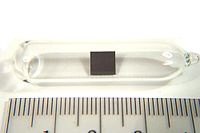
Photo from wikipedia
NaCT mediates citrate uptake in the liver cell line HepG2. When these cells were exposed to iron (Fe3+), citrate uptake/binding as monitored by the association of [14C]-citrate with cells increased.… Click to show full abstract
NaCT mediates citrate uptake in the liver cell line HepG2. When these cells were exposed to iron (Fe3+), citrate uptake/binding as monitored by the association of [14C]-citrate with cells increased. However, there was no change in NaCT expression and function, indicating that NaCT was not responsible for this Fe3+-induced citrate uptake/binding. Interestingly however, the process exhibited substrate selectivity and saturability as if the process was mediated by a transporter. Notwithstanding these features, subsequent studies demonstrated that the iron-induced citrate uptake/binding did not involve citrate entry into cells; instead, the increase was due to the formation of citrate-Fe3+ chelate that adsorbed to the cell surface. Surprisingly, the same phenomenon was observed in culture wells without HepG2 cells, indicating the adsorption of the citrate-Fe3+ chelate to the plastic surface of culture wells. We used this interesting phenomenon as a simple screening technique for new iron chelators with the logic that if another iron chelator is present in the assay system, it would compete with citrate for binding to Fe3+ and prevent the formation and adsorption of citrate-Fe3+ to the culture well. This technique was validated with the known iron chelators deferiprone and deferoxamine, and with the bacterial siderophore 2,3-dihydroxybenzoic acid and the catechol carbidopa.
Journal Title: International Journal of Molecular Sciences
Year Published: 2022
Link to full text (if available)
Share on Social Media: Sign Up to like & get
recommendations!